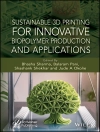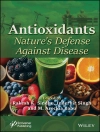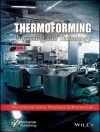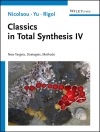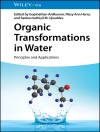Presenting a wide array of information on chemical ligation – one of the more powerful tools for protein and peptide synthesis – this book helps readers understand key methodologies and applications that protein therapeutic synthesis, drug discovery, and molecular imaging.
• Moves from fundamental to applied aspects, so that novice readers can follow the entire book and apply these reactions in the lab
• Presents a wide array of information on chemical ligation reactions, otherwise scattered across the literature, into one source
• Features comprehensive and multidisciplinary coverage that goes from basics to advanced topics
• Helps researchers choose the right chemical ligation technique for their needs
विषयसूची
List of Figures xiii
List of Plates xxiii
List of Contributors xxix
Preface xxxiii
1 Introduction to Chemical Ligation Reactions 1
Lucia De Rosa, Alessandra Romanelli, and Luca Domenico D’Andrea
1.1 Introduction 1
1.1.1 Chemical Synthesis of Proteins: From the Stepwise Synthesis to the Chemical Ligation Approach 2
1.1.2 Chemical Modification of Proteins: From Conventional Methods to Chemoselective Labeling by Chemical Ligation 5
1.2 Chemical Ligation Chemistries 6
1.3 Imine Ligations 7
1.3.1 Oxime Ligation 7
1.3.2 Hydrazone Ligation 13
1.3.3 Pictet–Spengler Ligation 15
1.3.4 Thiazolidine Ligation 19
1.4 Serine/Threonine Ligation (STL) 21
1.5 Thioether Ligation 24
1.6 Thioester Ligation 25
1.6.1 Native Chemical Ligation (NCL) 26
1.6.2 Expressed Protein Ligation (EPL) 40
1.6.2.1 Protein trans‐Splicing (PTS) 43
1.6.3 Thioacid‐Mediated Ligation Strategies 44
1.7 α‐Ketoacid‐Hydroxylamine (KAHA) Ligation 49
1.7.1 Acyltrifluoroborates and Hydroxylamines Ligation 51
1.8 Staudinger Ligation 52
1.9 Azide–Alkyne Cycloaddition 57
1.10 Diels–Alder Ligation 61
References 64
2 Protein Chemical Synthesis by SEA Ligation 89
Oleg Melnyk, Claire Simonneau, and Jérôme Vicogne
2.1 Introduction 89
2.2 Essential Chemical Properties of SEA Group 93
2.3 Protein Total Synthesis Using SEA Chemistry – SEAon/off Concept 97
2.3.1 Synthesis of SEA off Peptide Segments 97
2.3.2 SEAon/off Concept and the Design of a One-Pot Three Peptide Segment Assembly Process 99
2.3.3 SEAon/off Concept and the Solid-Phase Synthesis of Proteins in the N-to-C Direction 103
2.4 Chemical Synthesis of HGF/SF Subdomains for Deciphering the Functioning of HGF/SF-MET System 106
2.5 Conclusion 114
References 114
3 Development of Serine/Threonine Ligation and Its Applications 125
Tianlu li and Xuechen li
3.1 Introduction 125
3.1.1 Protein Synthesis by SPPS 125
3.1.2 Native Chemical Ligation (and Extended Desulfurization) 125
3.1.3 KAHA Ligation 128
3.2 Serine/Threonine Ligation (STL) 130
3.2.1 SAL Ester Preparation 130
3.2.2 N‐Terminal‐Protecting Group for Successive C‐to‐N Ser/Thr Ligations 136
3.2.3 Scope and Limitations 137
3.2.3.1 Effect of Side‐Chain‐Unprotected Lys Residue 137
3.2.3.2 Effect of the C‐Terminal Amino Acid at Ligation Site 138
3.3 Application of STL in Protein Synthesis 140
3.3.1 Consecutive STL of Peptides/Proteins 140
3.3.1.1 Teriparatide (Forteo) 140
3.3.1.2 h GH‐RH 141
3.3.1.3 Human Erythrocyte Acylphosphatase (ACYP1) 142
3.3.1.4 MUC1 Glycopeptides 143
3.3.2 STL‐Mediated Peptide Cyclization 143
3.3.2.1 STL in Head‐to‐Tail Tetrapeptide Cyclization 143
3.3.2.2 STL in Head‐to‐Tail Cyclization of Peptides of Various Sizes 145
3.3.2.3 Total Synthesis of Daptomycin via Serine‐Ligation‐Mediated Peptide Cyclization 145
3.3.3 Thiol SAL Ester‐Mediated Aminolysis in Peptide Cyclization 147
3.3.4 A Fluorogenic Probe for Recognizing 5‐OH‐Lys Inspired by STL 149
3.3.5 Expressed Protein Semisynthesis via Ser/Thr Ligation 151
3.4 Conclusion and Outlook 154
References 154
4 Synthesis of Proteins by Native Chemical Ligation–Desulfurization Strategies 161
Bhavesh Premdjee and Richard J. Payne
4.1 Introduction 161
4.2 Ligation–Desulfurization and Early Applications 162
4.2.1 Metal‐Free Desulfurization 164
4.2.2 Ligation–Desulfurization toward the Synthesis of Proteins 166
4.3 Beyond Native Chemical Ligation at Cysteine – The Development of Thiolated Amino Acids and Their Application in Protein Synthesis 174
4.3.1 Phenylalanine 174
4.3.2 Valine 178
4.3.3 Lysine 179
4.3.4 Threonine 188
4.3.5 Leucine 188
4.3.6 Proline 193
4.3.7 Glutamine 195
4.3.8 Arginine 198
4.3.9 Aspartic Acid 198
4.3.10 Glutamic Acid 202
4.3.11 Tryptophan 206
4.3.12 Glc NAc‐Asparagine 206
4.3.13 Asparagine 206
4.4 Ligation–Deselenization in the Chemical Synthesis of Proteins 211
4.4.1 Selenol Amino Acids 214
4.5 Conclusions and Future Directions 216
References 218
5 Synthesis of Chemokines by Chemical Ligation 223
Nydia Panitz and Annette G. Beck‐Sickinger
5.1 Introduction – The Chemokine–Chemokine Receptor Multifunctional System 223
5.2 Synthesis of Chemokines by Native Chemical Ligation 224
5.3 Synthesis of Chemokines by Alternative Chemical Ligation 231
5.4 Semisynthesis of Chemokines by Expressed Protein Ligation 233
5.5 Prospects 241
References 243
6 Chemical Synthesis of Glycoproteins by the Thioester Method 251
Hironobu Hojo
6.1 Introduction 251
6.2 Ligation Methods and Strategy of Glycoprotein Synthesis 252
6.3 The Synthesis of the Extracellular Ig Domain of Emmprin 254
6.4 Synthesis of Basal Structure of MUC 2 256
6.5 N‐Alkylcysteine‐Assisted Thioesterification Method and Dendrimer Synthesis 257
6.6 Synthesis of TIM‐3 260
6.7 Resynthesis of Emmprin Ig Domain 262
6.8 Conclusion 264
References 264
7 Membrane Proteins: Chemical Synthesis and Ligation 269
Marc Dittman and Martin Engelhard
7.1 Introduction 269
7.2 Methods for the Synthesis and Purification of Membrane Proteins 270
7.2.1 Synthesis of Hydrophobic Peptides 270
7.2.2 Purification of Hydrophobic Peptides 272
7.3 Ligation and Refolding 273
7.3.1 Ligation Strategies 273
7.3.2 Refolding of Chemically Synthesized Hydrophobic Peptides and Membrane Proteins 275
7.4 Illustrative Examples 276
7.4.1 Diacylglycerol Kinase (DAGK) 276
7.4.2 Semisynthesis of the Sensory Rhodopsin/Transducer Complex 278
7.4.3 Semisynthesis of the Functional K + Channel Kcs A 279
References 280
8 Chemoselective Modification of Proteins 285
xi Chen, Stephanie Voss, and Yao-wen Wu
8.1 Chemical Protein Synthesis 285
8.1.1 Native Chemical Ligation (NCL) and Expressed Protein Ligation (epl) 285
8.1.2 Traceless Staudinger Ligation 286
8.2 Chemoselective and Bioorthogonal Reactions 287
8.2.1 Oxime/Hydrazone Ligation 287
8.2.2 Staudinger Ligations 294
8.2.3 Copper-Catalyzed Azide–Alkyne Cycloaddition (Cu AAC) 294
8.2.4 Strain-Promoted Azide–Alkyne Cycloaddition (SPAAC) 297
8.2.5 Inverse Electron-Demand Diels–Alder Cycloaddition (DA INV) 300
8.2.6 Light-Induced Click Reactions 303
8.2.7 1, 2-Aminothiol Condensation 304
8.2.8 Transition-Metal-Catalyzed Couplings 305
8.2.9 Miscellaneous Protein-Labeling Reactions 306
8.3 Site-Selective Protein Modification Approaches 307
8.3.1 Site-Selective Modification of Native Proteins 307
8.3.1.1 Cysteine (Cys), dehydroalanine (Dha), and disulfides 307
8.3.1.2 N-Terminal Protein Labeling 309
8.3.1.3 Kinetically-Controlled Protein Labeling (KPL) 309
8.3.1.4 Affinity Labeling for Site-Specific Labeling of Native Proteins 310
8.3.2 Chemical Tags for Labeling Proteins in Live Cells 311
8.3.2.1 Self-Labeling Peptide Tags 312
8.3.2.2 Ligand-Binding Domains 317
8.3.2.3 Self-Labeling Enzymatic Domains 317
8.3.2.4 Enzymatic Modifications 318
8.3.2.5 Metal Chelation 318
8.3.3 Unnatural Amino Acid Mutagenesis 319
8.3.3.1 Residue-Specific UAA Mutagenesis Via SPI 319
8.3.3.2 Site-Specific UAA Incorporation 322
References 322
9 Stable, Versatile Conjugation Chemistries for Modifying Aldehyde-Containing Biomolecules 339
Aaron E. Albers, Penelope M. Drake and David Rabuka
9.1 Introduction 339
9.2 Aldehyde as a Bioorthogonal Chemical Handle for Conjugation 339
9.3 Aldehyde Conjugation Chemistries 340
9.4 The Pictet–Spengler Ligation 341
9.5 The Hydrazinyl-Iso-Pictet–Spengler (HIPS) Ligation 341
9.6 The Trapped-Knoevenagel (thio Pz) Ligation 343
9.7 Applications – Antibody–Drug Conjugates 346
9.8 Next-Generation HIPS Chemistry – Aza HIPS 348
9.9 Applications – Protein Engineering 349
9.10 Applications – Protein Labeling 349
9.11 Conclusions 351
References 351
10 Thioamide Labeling of Proteins through a Combination of Semisynthetic Methods 355
Christopher R. Walters, John J. Ferrie, and E. James Petersson
10.1 Introduction 355
10.2 Thioamide Synthesis 356
10.3 Thioamide Incorporation into Peptides 357
10.4 Synthesis of Full‐Sized Proteins Containing Thioamides 360
10.5 Applications 368
10.5.1 Structural Studies 368
10.5.2 Use as Photoswitches 371
10.5.3 Site‐Specific Circular Dichroism Labels 373
10.5.4 Fluorescence Quenching 374
10.5.5 Protein Folding in Model Systems 375
10.5.6 Monitoring Proteolysis 377
10.5.7 α‐Synuclein Misfolding Studies 379
10.6 Conclusions 381
Acknowledgments 381
References 382
11 Macrocyclic Organo-Peptide Hybrids by Intein-Mediated Ligation: Synthesis and Applications 391
John R. Frost and Rudi Fasan
11.1 Introduction 391
11.1.1 Naturally Occurring Macrocyclic Peptides 392
11.1.2 Natural Product Analogs via Reengineering of NRPS and PRPS Biosynthetic Pathways 395
11.2 Macrocyclic Organo-Peptide Hybrids as Natural-Product-Inspired Macrocycles 396
11.2.1 MOr PHs via Cu AAC/Hydrazide-Mediated Ligation 398
11.2.2 Catalyst-Free MOr PH Synthesis via Oxime/AMA-Mediated Ligation 401
11.2.3 Structure–Reactivity Relationships in MOr PH Synthesis 401
11.2.4 Synthesis of MOr PH Libraries 404
11.2.5 Macrocyclization Mechanism 405
11.2.6 Bicyclic Organo-Peptide Hybrids 406
11.3 Application of MOr PHs for Targeting α-Helix-Mediated Protein– Protein Interactions 406
11.4 Conclusions 410
References 410
12 Protein Ligation by HINT Domains 421
Hideo Iwaï and A. Sesilja Aranko
12.1 Introduction 421
12.2 Protein Ligation by Protein Splicing 423
12.3 Naturally Occurring and Artificially Split Inteins for Protein Ligation 424
12.4 Conditional Protein Splicing 427
12.5 Inter- and Intramolecular Protein Splicing 429
12.6 Protein Ligation by Other HINT Domains 430
12.7 Bottleneck of Protein Ligation by PTS 432
12.8 Comparison with Other Enzymatic Ligation Methods 432
12.9 Perspective of Protein Ligation by HINT Domains 437
12.10 Conclusions and Future Perspectives 438
Acknowledgment 438
References 438
13 Chemical Ligation for Molecular Imaging 447
Aurélien Godinat, Hacer Karatas, Ghyslain Budin, and Elena A. Dubikovskaya
13.1 Introduction 447
13.2 Chemical Ligation 448
13.2.1 Classical Chemical Ligation 448
13.2.2 Bioorthogonal Chemistry 450
13.2.2.1 Bioorthogonal Chemistry for Optical Imaging 454
13.2.2.2 Bioorthogonal Chemistry for Nuclear Imaging (PET, SPECT) 462
13.2.2.3 Bioorthogonal Chemistry for Magnetic Resonance Imaging (mri) 469
13.3 Conclusion 470
References 473
14 Native Chemical Ligation in Structural Biology 485
Lucia De Rosa, Alessandra Romanelli, and Luca Domenico D’Andrea
14.1 Introduction 485
14.2 Protein (Semi)synthesis for Molecular Structure Determination 486
14.3 Protein (Semi)Synthesis for Understanding Protein Folding, Stability, and Interactions 494
14.4 Protein (Semi)Synthesis in Enzyme Chemistry 501
References 506
Index 517
लेखक के बारे में
Luca D. D’Andrea, Ph D, is Research Scientist at the Institute of Biostructures and Bioimaging, CNR Naples, Italy. His scientific interests are in the field of peptide and protein chemistry. His research activity focuses on design, synthesis, and structural characterization of peptide/proteins as therapeutic/diagnostic agents.
Alessandra Romanelli, Ph D, is assistant professor of General Chemistry at Department of Pharmacy, University of Naples ‘Federico II’, Italy. She actively works in the field of peptides and peptide-based molecules (such as peptide nucleic acids) as tools for chemical biology.


